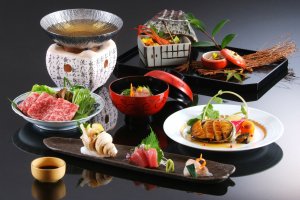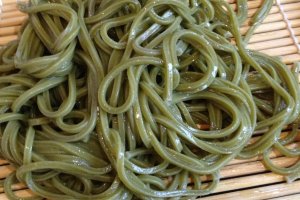Overview
With its refined and elegant heritage, Kyoto prefecture and its recognised cuisine offers some of the most exquisite culinary experiences in the nation. Foods prepared here take on the influence of a millennium of Imperial power and prestige and include simple pickled dishes based on rarefied traditions of preparation, seasonal shoots exhibiting the best of culinary timing and the sophisticated simplicity of green tea and soba. Add in Kyoto's world famous grand cuisine, and you have a prefecture that is justifiably in its own gastronomical world. Here is a simple guide to some of the regional cuisine of Kyoto.
Kyo-tsukemono
Served alongside almost every meal, it can be easy to overlook just how representative of Kyoto cuisine, Kyo-tsukemono are. Essentially pickled vegetables, Kyoto's famous accompaniments to meals are one of a kind. Pickled with a minimal amount of salt, these traditional bites rely on the inherent flavours of the vegetables for their effect.

Takenoko
A seasonal food if there ever was one, takenoko are young bamboo shoots and a decided speciality of Kyoto. Particularly well-matched with miso and peppers, fresh shoots are only available in the spring and are usually enjoyed as a simmered dish, freshly dug in the morning as sashimi or served with rice.

Cha soba
Originating with the famous matcha green teas of Uji, cha soba green tea buckwheat noodles are an iconic food in Kyoto. Eaten as either a warm or cold dish, these fresh tasting noodles embody a richly green tea hue, one suggestive of the depth of heritage that is unashamedly Kyoto.

Kaiseki ryori
No guide to food in Kyoto is complete without mentioning kaiseki ryori, Japan's world recognised haute cuisine. Continually evolving, this traditional multi-course meal is intimately intertwined with the nation's history, drawing influences from the Imperial court, Buddhist temple cuisine, samurai foods and the tea ceremony.






























Our chefs also take dietary requirements very seriously; rather than just rip the offending articles out of the dishes, they will prepare a bespoke kaiseki loosely based on the current menu in line with the guests requirements.
懐石料理 Kaiseki was developed alongside Tea Ceremony and the kanji can be roughly translated as “bosom stone cuisine”. It takes its name from a technique where Buddhist monks would place a warm stone inside their robes to banish the feeling of hunger.
懐石料理 was a very simple meal of soup, rice and maybe raw fish, together with a few other dishes that would be shared with other guests. This meal was eaten before a Tea Ceremony to act like the warm stone to prevent guests feeling hungry during the ceremony.
会席料理 is actually the type of Kaiseki that you will most often experience in Japan and the one that we serve at Nanten-en. It refers to the complex course dinner of beautifully prepared dishes. It has its origin in the cuisine eaten by Daimyo and filtered down to the common people. It was based around the drinking of sake and each course was designed to complement the drink perfectly.
I only had takenoko in Tarui (Gifu), it has really surprising taste, nothing like the usual bamboo shoots.
I probably make it sound a lot worse than it was...